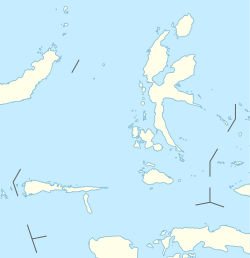Taliabu Island Regency Kabupaten Pulau Taliabu | |
|---|---|
 Students seen playing volleyball at the local school | |
| Motto(s): Hemungsia Siadufu (Together and United) | |
 Location within Maluku Islands | |
| Coordinates: 1°48′S124°48′E / 1.8°S 124.8°E | |
| Country | |
| Province | |
| Established | 14 December 2012 |
| Capital | Bobong |
| Government | |
| • Regent | Sashabila Mus |
| • Vice Regent | La Ode Yasir |
| Area | |
• Total | 2,775.30 km2 (1,071.55 sq mi) |
| Population (mid 2024 estimate) | |
• Total | 66,361 |
| • Density | 23.911/km2 (61.930/sq mi) |
| [1] | |
| Time zone | UTC+9 (IEST) |
| Area code | (+62) 921 |
| Website | taliabukab |
Taliabu Island Regency (Indonesian : Kabupaten Pulau Taliabu) is a regency in the North Maluku province of Indonesia, consisting primarily of the island of Taliabu, the most western, geographically, of the Sula Archipelago. It is located to the west of Mangole Island and Sanana Island, the two islands which remain part of the former Sula Islands Regency; until 14 December 2012, when it was administratively-separated into its own regency, Taliabu had been a part of the Sula Islands Regency. Presently, Taliabu Island Regency (including minor offshore islands, predominantly to the west and southwest of Taliabu proper) covers roughly 2,775.30 km2 (582 mi2). Taliabu had a population of 47,309 at the 2010 Census [2] and 58,047 at the 2020 Census; [3] the official estimate as at mid 2024 was 66,361 (comprising 33,930 males and 32,431 females). [1]



